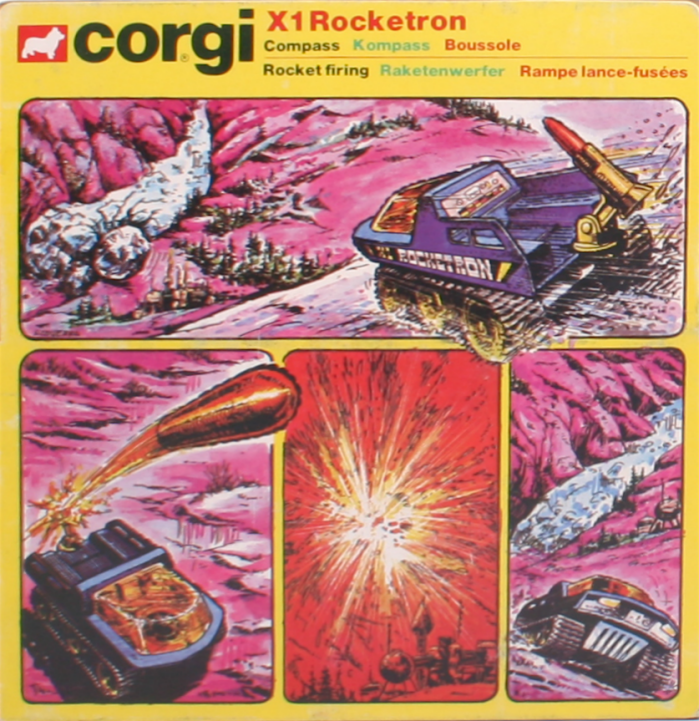Exhibit / April 05, 2018
Object Name: X-Ploratrons
Maker and Year: Corgi Toys, 1979
Object Type: Die-cast toy
Description: (Richard McKenna)
Though aimed at children, the short-lived X-Ploratrons series of toys was a perfect, albeit inadvertent, précis of the Western world’s confused and discomfited feelings about its relationship with nature circa 1979, when pollution, overpopulation, and environmental depredation were on the rise.
Billed as “global guardians,” the X-Ploratrons were four toy vehicles, each equipped with its own novelty tool—mirror, magnifying glass, compass, and magnet—and charged with protecting humanity in the “fictitious disaster-wrecked world of the 21st century,” where “the elements rebel against man!” They were long-established die-cast toy brand Corgi’s attempt to adapt to the wave of SF-driven commerce that followed the unprecedented success of Star Wars and which, two years later, was still dictating market realities and forcing companies to find ways to appeal to the new tastes.
Corgi toys was a subdivision of Mettoy, a company founded in 1933 by two Jewish immigrants—Philip Ullmann and his first cousin once removed, Arthur Katz—who had come to Britain to escape escalating Nazi persecution. In Nuremberg, Ullmann had been the owner of toy company Tipp & Co., which also employed Katz. In order to raise funds for other Jewish refugees, they began producing the tinplate lithographed toys that were a specialty of the Nuremberg toy industry together in the UK. Over the course of World War II, Mettoy shifted its production entirely over to munitions, earning itself a reputation for speed and technical innovation. It returned to toys after the war was over, and, in 1949, opened Playcraft, which produced toys in molded plastic. In 1956, Mettoy brought together its precision casting and plastics know-how in Corgi’s line of cutting-edge toy cars, promoted as “The Ones with Windows” in order to highlight their technical superiority over the other, more rudimentary die-cast toys on the market. The company was quick to pursue the advantages offered by licensing, and its line of well-known vehicles from film and TV went on the include the Batmobile, the Monkeemobile, The Beatles’ titular Yellow Submarine, the Aston Martin DB5 featured in the James Bond films, and the Charlie’s Angels‘ van.
As the 1970s progressed, however, the British toy business was a victim of the same decline afflicting the rest of the country, and Corgi saw profits falling as innovative new competitors like US brand Hot Wheels entered the market. The mania for space-related product was also becoming overwhelming: in 1978, one of Corgi’s domestic rivals, Matchbox, released the Adventure 2000 series of futuristic vehicles, while its other main British competitor, Dinky, offered a range of sci-fi merchandise with products like its die-cast USS Enterprise and licensed Gerry Anderson toys, including the Eagle Transporter from Space: 1999.
Corgi retaliated by releasing a new line that attempted to fuse cosmic appeal with the pragmatic do-gooding of its range of emergency vehicles. The empty, apocalyptic world these unmanned devices policed was, however, incongruously elegiac and their backstory vague and disturbing. Why had nature rebelled against humanity? And was it really possible to fight back against it? Furthermore, despite their name, exploration seemed to play little part in the X–Ploratron’s world. Perhaps it was for this reason that the line failed to capture the imagination of its intended consumers and ceased production after a single year. Though possessed of an awkward, bulky charm, the X-Ploratrons lacked the authority and (more surprisingly, given the company’s reputation) the detail of the Adventure 2000 vehicles with which they were so clearly intended to compete; and there were no promotional tie-ins to bolster sales, such as Matchbox attempted with the Judge Dredd strip in 2000 AD.
Ironically, it was a comic artist working for 2000 AD who provided the back covers for the X-Ploratrons boxes: Spaniard Carlos Ezquerra, best known for devising the physical appearances of Judge Dredd and Strontium Dog. With its lurid evocation of a doomed planet of deserts, swamps, and nocturnal cities under siege from nature itself, Ezquerra’s artwork highlights perfectly the inherent contradiction at the heart of the X-Ploratron series: a nodding towards a kind of eco-awareness while positing bellicose machine interventionism as a response; a gloomy echo of what was happening in the real world, where man-made ecological disaster was being held off by the same technologies that were helping to cause it.










These are quite interesting. The art looks remarkably like what was found in some of the G.I. Joe Adventure Team play set and vehicle inserts from the early to mid-1970s.
Pingback: Warrior Monks and Video Technoids: Documents of the First Earth Battalion, 1979 – 1982
Pingback: Mutating Empire: Britains’ ‘Space’ Toys
Pingback: Remembrance of Ramps Past: Hot Wheels Service Center Playset, 1979
Pingback: “God Likes Winners”: Catharsis and Community in 1970s Disaster Movies